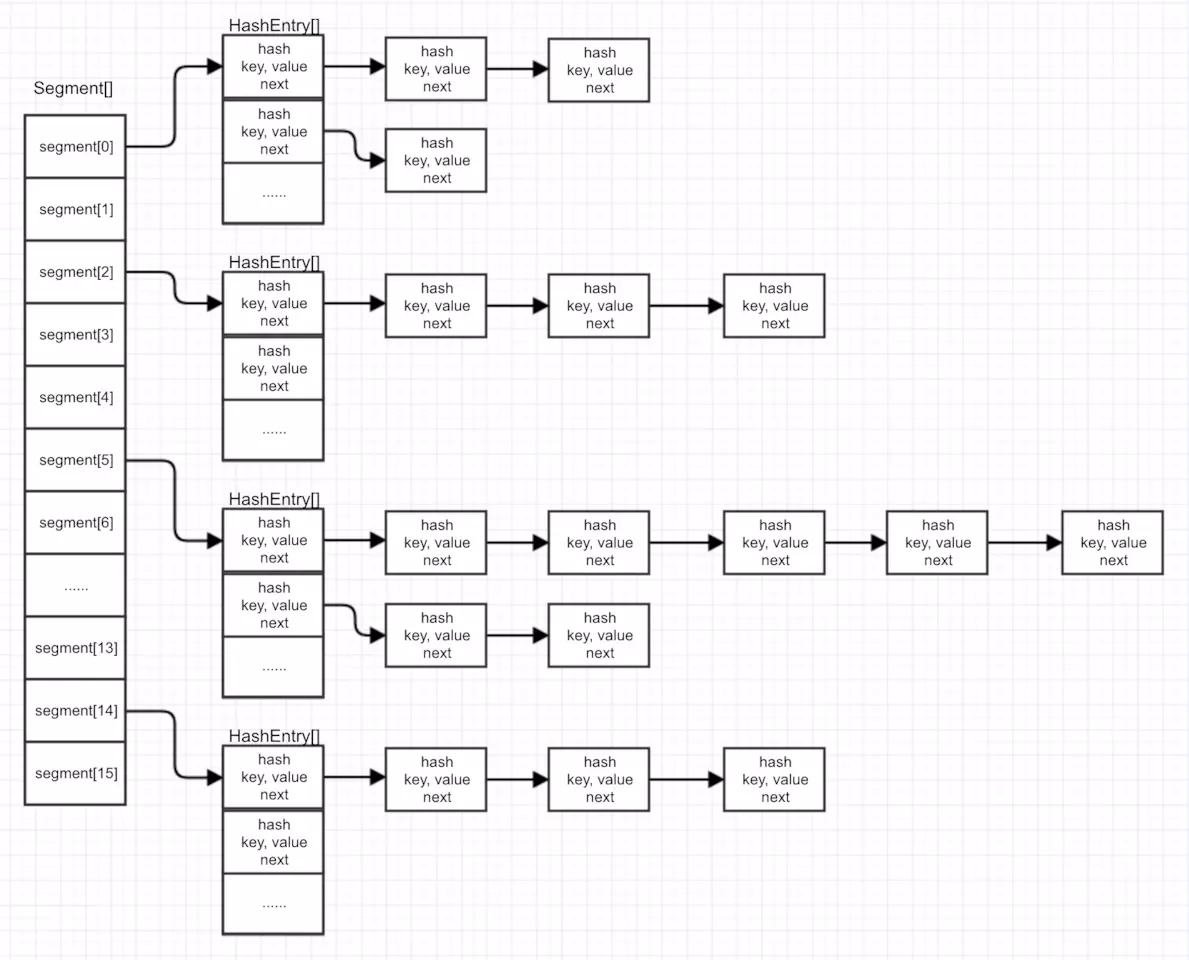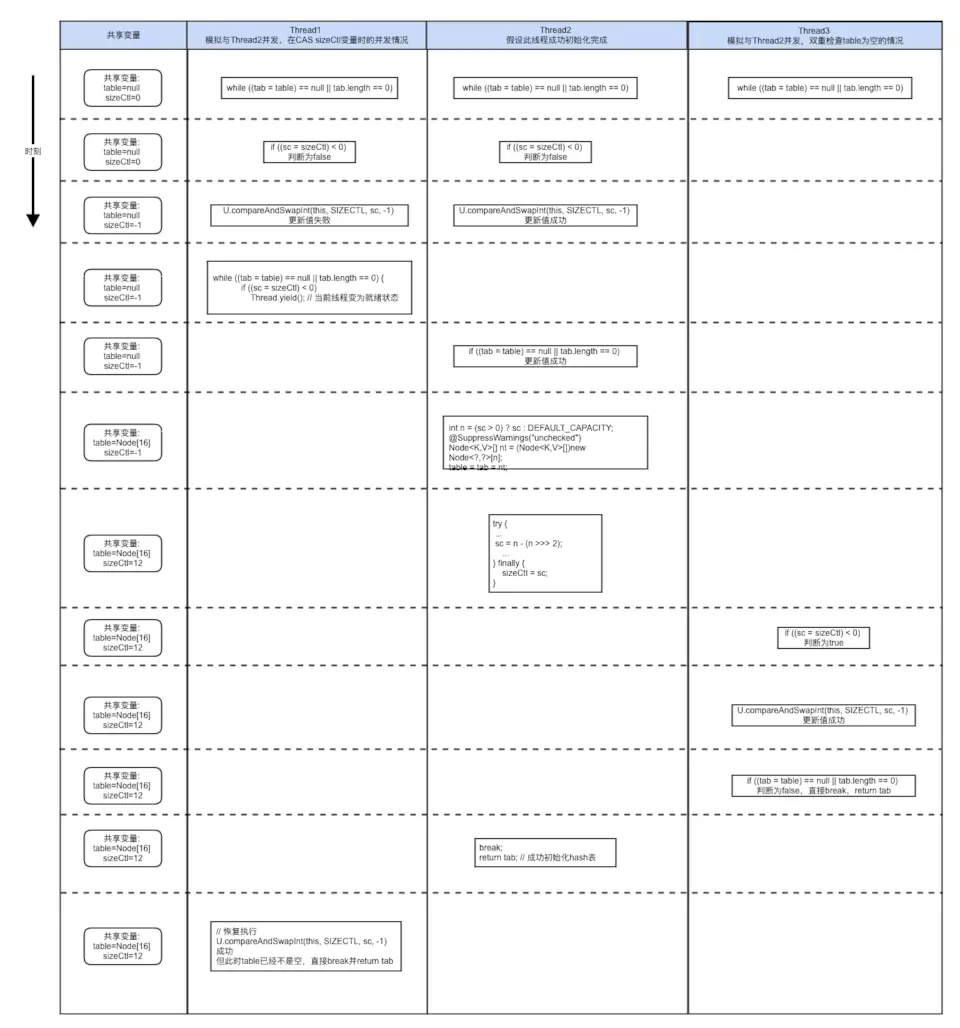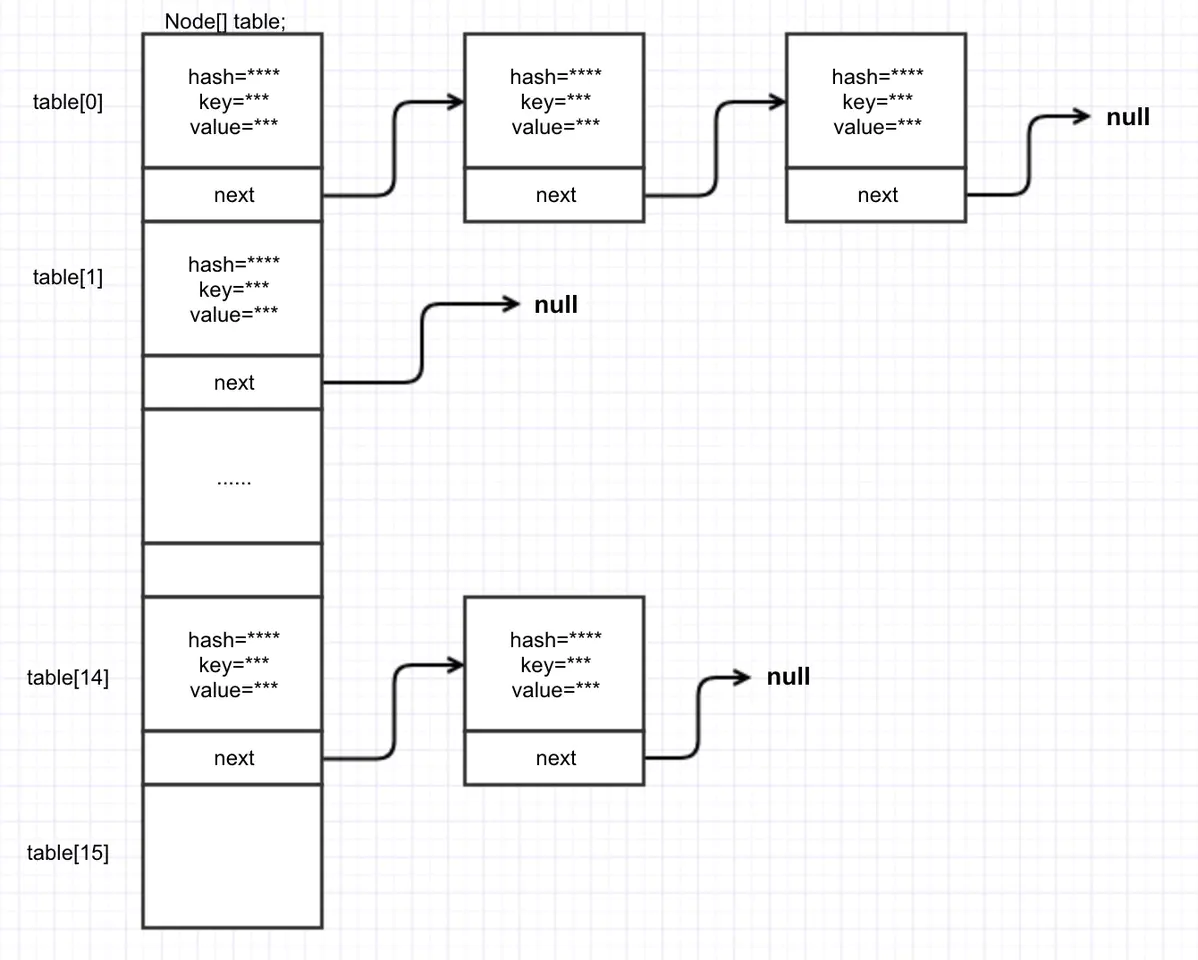5.1 Map
5.1.1 HashMap底层原理
final V putVal(int hash, K key, V value, boolean onlyIfAbsent,boolean evict) {//判断table是否为空,如果是空的就创建一个table,并获取他的长度Node<K,V>[] tab; Node<K,V> p; int n, i;if ((tab = table) == null || (n = tab.length) == 0)n = (tab = resize()).length;//如果计算出来的索引位置之前没有放过数据,就直接放入if ((p = tab[i = (n - 1) & hash]) == null)tab[i] = newNode(hash, key, value, null);else {//进入这里说明索引位置已经放入过数据了Node<K,V> e; K k;//判断put的数据和之前的数据是否重复if (p.hash == hash &&((k = p.key) == key || (key != null && key.equals(k)))) //key的地址或key的equals()只要有一个相等就认为key重复了,就直接覆盖原来key的valuee = p;//判断是否是红黑树,如果是红黑树就直接插入树中else if (p instanceof TreeNode)e = ((TreeNode<K,V>)p).putTreeVal(this, tab, hash, key, value);else {//如果不是红黑树,就遍历每个节点,判断链表长度是否大于8,如果大于就转换为红黑树for (int binCount = 0; ; ++binCount) {if ((e = p.next) == null) {p.next = newNode(hash, key, value, null);if (binCount >= TREEIFY_THRESHOLD - 1) // -1 for 1sttreeifyBin(tab, hash);break;}//判断索引每个元素的key是否可要插入的key相同,如果相同就直接覆盖if (e.hash == hash &&((k = e.key) == key || (key != null && key.equals(k))))break;p = e;}}//如果e不是null,说明没有迭代到最后就跳出了循环,说明链表中有相同的key,因此只需要将value覆盖,并将oldValue返回即可if (e != null) { // existing mapping for keyV oldValue = e.value;if (!onlyIfAbsent || oldValue == null)e.value = value;afterNodeAccess(e);return oldValue;}}//说明没有key相同,因此要插入一个key-value,并记录内部结构变化次数++modCount;if (++size > threshold)resize();afterNodeInsertion(evict);return null;}
HashMap存储的是key-value的键值对,允许key为null,也允许value为null。HashMap内部为数组+链表的结构,
static final int tableSizeFor(int cap) {int n = cap - 1;n |= n >>> 1;n |= n >>> 2;n |= n >>> 4;n |= n >>> 8;n |= n >>> 16;return (n < 0) ? 1 : (n >= MAXIMUM_CAPACITY) ? MAXIMUM_CAPACITY : n + 1;}
返回 传入值的最小的2的n次方的值 比如 7 -> 8 12->16
static final int hash(Object key) {int h;//h >>> 16,表示无符号右移16位,高位补0,任何数跟0异或都是其本身,因此key的hash值高16位不变return (key == null) ? 0 : (h = key.hashCode()) ^ (h >>> 16); //}
int n = 8;for(int j = 1; j < 100; j++) {int num = new Random().nextInt(100000000);Object o = (Object)(num);if(j % 8 == 0) {n = n + 8;}int h;System.err.println((n - 1) & ((h = o.hashCode()) ^ (h >>> 16)));}
上面代码是hashmap 获取下标的原理,n是map的大小,数组的下标为 (n - 1) & hashcode,就是数据大小和hashcode做&运算,得到的大小就是 ** 0-数组大小。
为了降低hash的冲突,尽量让hash分散和数组下标尽量取决于hashcode:
1:hashcode 前后16位做 异或 运算,降低hashcode 相同
2:让数组大小为 2 n -1 。就是让2进制的数字后面位数都是1。
当扩容后 扩容后的数组大小是之前的两倍 也就是二进制的数值左移一位,也就是多了一个1 ,那么在做 (n - 1) & hashcode 的时候 ,要么hashCode的 值 运算的结果 比 要么是之前的下标 i 要么是 之前的 i + n
会根据key的hashCode值来确定数组的索引(确认放在哪个桶里),如果遇到索引相同的key,桶的大小是2,如果一个key的hashCode是7,一个key的hashCode也是7,那么他们就会被分到一个桶中(hash冲突),如果发生hash冲突,HashMap会将同一个桶中的数据以链表的形式存储,但是如果发生hash冲突的概率比较高,就会导致同一个桶中的链表长度过长,遍历效率降低,所以在JDK1.8中如果链表长度到达阀值(默认是8),就会将链表转换成红黑二叉树。**
两个key的hashCode可能会定位到一个桶中,这时就发生了hash冲突,如果HashMap的hash算法越散列,那么发生hash冲突的概率越低,如果数组越大,那么发生hash冲突的概率也会越低,但是数组越大带来的空间开销越多,但是遍历速度越快,这就要在空间和时间上进行权衡,这就要看看HashMap的扩容机制
threshold=负载因子 * length ,
大于 threshold 会进行扩容
也就是说数组长度固定以后, 如果负载因子越大,所能容纳的元素个数越多,如果超过这个值就会进行扩容(默认是扩容为原来的2倍),0.75这个值是权衡过空间和时间得出的,建议大家不要随意修改,如果在一些特殊情况下,比如空间比较多,但要求速度比较快,这时候就可以把扩容因子调小以较少hash冲突的概率。相反就增大扩容因子(这个值可以大于1)。
size就是HashMap中键值对的总个数。还有一个字段是modCount,记录是发生内部结构变化的次数,如果put值,但是put的值是覆盖原有的值,这样是不算内部结构变化的。
因为HashMap扩容每次都是扩容为原来的2倍,所以length总是2的次方,这是非常规的设置,常规设置是把桶的大小设置为素数,因为素数发生hash冲突的概率要小于合数,比如HashTable的默认值设置为11,就是桶的大小为素数的应用(HashTable扩容后不能保证是素数)。HashMap采用这种设置是为了在取模和扩容的时候做出优化。
hashMap是通过key的hashCode的高16位和低16位异或后和桶的数量取模得到索引位置,即key.hashcode()^(hashcode>>>16)%length,当length是2^n时,h&(length-1)运算等价于h%length,而&操作比%效率更高。而采用高16位和低16位进行异或,也可以让所有的位数都参与越算,使得在length比较小的时候也可以做到尽量的散列。
在扩容的时候,如果length每次是2^n,那么重新计算出来的索引只有两种情况,一种是 old索引+16,另一种是索引不变,所以就不需要每次都重新计算索引。
使用对象做为map的key的时候 要注意需要重新 hashcode 和 equal 方法
public static void main(String[] args) {Map<Person,String> map = new HashMap<>(8);Person gege = new Person();gege.setAge(3);gege.setName("gege");map.put(gege,"哥哥");Person didi = new Person();didi.setAge(1);didi.setName("didi");map.put(didi,"弟弟");System.out.println(map.get(gege));System.out.println(map.get(didi));// 加入这个map传递给另一个方法,此时这个方法想拿到一个哥哥// new一个哥哥出来去getPerson dagege = new Person();dagege.setName("gege");dagege.setAge(3);System.out.println(map.get(dagege));System.out.println(dagege.hashCode());System.out.println(gege.hashCode());}
不重写的时候 当去获取的时候 ,重新new一个对象 ,去当做key的时候,由于两个hashcode 不一样 更加不会equals 所以,获取不到之前的对象。
5.1.2 TreeMap底层原理
public V put(K key, V value) {Entry<K,V> t = root; //获取根节点if (t == null) { // 如果根节点为空,则该元素置为根节点compare(key, key); // type (and possibly null) checkroot = new Entry<>(key, value, null);size = 1;modCount++;return null;}int cmp;Entry<K,V> parent;// split comparator and comparable pathsComparator<? super K> cpr = comparator; // 比较器对象// 如果比较器对象不为空,也就是自定义了比较器if (cpr != null) {do { // 循环比较并确定元素应插入的位置(也就是找到该元素的父节点)parent = t;// 调用比较器对象的compare()方法,该方法返回一个整数cmp = cpr.compare(key, t.key);if (cmp < 0) // 待插入元素的key"小于"当前位置元素的key,则查询左子树t = t.left;else if (cmp > 0)// 待插入元素的key"大于"当前位置元素的key,则查询右子树t = t.right;elsereturn t.setValue(value); // "相等"则替换其value。} while (t != null);}else { // 如果比较器对象为空,使用默认的比较机制if (key == null)throw new NullPointerException();@SuppressWarnings("unchecked")Comparable<? super K> k = (Comparable<? super K>) key; // 取出比较器对象do { // 同样是循环比较并确定元素应插入的位置(也就是找到该元素的父节点)parent = t;cmp = k.compareTo(t.key);// 同样调用比较方法并返回一个整数if (cmp < 0) // 待插入元素的key"小于"当前位置元素的key,则查询左子树t = t.left;else if (cmp > 0) // 待插入元素的key"大于"当前位置元素的key,则查询右子树t = t.right;elsereturn t.setValue(value); // "相等"则替换其value。} while (t != null);}Entry<K,V> e = new Entry<>(key, value, parent); // 根据key找到父节点后新建一个节点if (cmp < 0) // 根据比较的结果来确定放在左子树还是右子树parent.left = e;elseparent.right = e;fixAfterInsertion(e);size++; // 集合大小+1modCount++; // 集合结构被修改次数+1return null;}
TreeMap 底层是红黑树结构,可以排序,可以默认排序,或者自定义排序规则。
插入的数据按照红黑树的结构存储。
5.1.3 LinkedHashMap底层原理
linkedHashMap底层调用的是hashmap的方法,ListedHashMap 重写了 newNode
tab[i] = newNode(hash, key, value, null);
Node<K,V> newNode(int hash, K key, V value, Node<K,V> e) {LinkedHashMap.Entry<K,V> p =new LinkedHashMap.Entry<K,V>(hash, key, value, e);linkNodeLast(p);return p;}private void linkNodeLast(LinkedHashMap.Entry<K,V> p) {LinkedHashMap.Entry<K,V> last = tail;tail = p;if (last == null)head = p;else {p.before = last;last.after = p;}}static class Entry<K,V> extends HashMap.Node<K,V> {Entry<K,V> before, after;Entry(int hash, K key, V value, Node<K,V> next) {super(hash, key, value, next);}}
可以看到 Entry有两个指针 前 和 后,就是存放在数组中的Node的节点中都可以找到他前后的节点。
每次newNode 的时候 都会调用 linkNodeLast 方法,这时会记录head的值,记录head的值,就是可以在便利的时候依次输出每个node,因为每个node都会存前一个before和后一个after
网上很多说是
void afterNodeAccess(Node<K,V> e) { // move node to lastLinkedHashMap.Entry<K,V> last;if (accessOrder && (last = tail) != e) {LinkedHashMap.Entry<K,V> p =(LinkedHashMap.Entry<K,V>)e, b = p.before, a = p.after;p.after = null;if (b == null)head = a;elseb.after = a;if (a != null)a.before = b;elselast = b;if (last == null)head = p;else {p.before = last;last.after = p;}tail = p;++modCount;}}
网上说的是在hashmap 提供的回调函数会调用 linkedHashMap的的上面这个方法,这个是LinkedHashMap 排序的关键,因为这个函数是在链表中排序的,也就是hash冲突的时候的排序,所以这个不是真正排序的关键代码。有待认证。
void afterNodeAccess(Node<K,V> e) { // move node to lastLinkedHashMap.Entry<K,V> last;if (accessOrder && (last = tail) != e) {LinkedHashMap.Entry<K,V> p =(LinkedHashMap.Entry<K,V>)e, b = p.before, a = p.after;p.after = null;if (b == null)head = a;elseb.after = a;if (a != null)a.before = b;elselast = b;if (last == null)head = p;else {p.before = last;last.after = p;}tail = p;++modCount;}}
上面的 方法是把这次入参的数据 ,放到链表的尾部。
5.1.4 CurrentHashMap底层原理
HashMap是工作中使用频度非常高的一个K-V存储容器。在多线程环境下,使用HashMap是不安全的,可能产生各种非期望的结果。
针对HashMap在多线程环境下不安全这个问题,HashMap的作者认为这并不是bug,而是应该使用线程安全的HashMap。
目前有如下一些方式可以获得线程安全的HashMap:
- Collections.synchronizedMap
- HashTable
- ConcurrentHashMap
其中,前两种方式由于全局锁的问题,存在很严重的性能问题。所以,著名的并发编程大师Doug Lea在JDK1.5的java.util.concurrent包下面添加了一大堆并发工具。其中就包含ConcurrentHashMap这个线程安全的HashMap。
本文就来简单介绍一下ConcurrentHashMap的实现原理。
PS:基于JDK8
0 ConcurrentHashMap在JDK7中的回顾
ConcurrentHashMap在JDK7和JDK8中的实现方式上有较大的不同。首先我们先来大概回顾一下ConcurrentHashMap在JDK7中的原理是怎样的。
0.1 分段锁技术
针对HashTable会锁整个hash表的问题,ConcurrentHashMap提出了分段锁的解决方案。
分段锁的思想就是:锁的时候不锁整个hash表,而是只锁一部分。
如何实现呢?这就用到了ConcurrentHashMap中最关键的Segment。
ConcurrentHashMap中维护着一个Segment数组,每个Segment可以看做是一个HashMap。
而Segment本身继承了ReentrantLock,它本身就是一个锁。
在Segment中通过HashEntry数组来维护其内部的hash表。
每个HashEntry就代表了map中的一个K-V,用HashEntry可以组成一个链表结构,通过next字段引用到其下一个元素。
上述内容在源码中的表示如下:
public class ConcurrentHashMap<K, V> extends AbstractMap<K, V>implements ConcurrentMap<K, V>, Serializable {// ... 省略 .../*** The segments, each of which is a specialized hash table.*/final Segment<K,V>[] segments;// ... 省略 .../*** Segment是ConcurrentHashMap的静态内部类** Segments are specialized versions of hash tables. This* subclasses from ReentrantLock opportunistically, just to* simplify some locking and avoid separate construction.*/static final class Segment<K,V> extends ReentrantLock implements Serializable {// ... 省略 .../*** The per-segment table. Elements are accessed via* entryAt/setEntryAt providing volatile semantics.*/transient volatile HashEntry<K,V>[] table;// ... 省略 ...}// ... 省略 .../*** ConcurrentHashMap list entry. Note that this is never exported* out as a user-visible Map.Entry.*/static final class HashEntry<K,V> {final int hash;final K key;volatile V value;volatile HashEntry<K,V> next;// ... 省略 ...}}
所以,JDK7中,ConcurrentHashMap的整体结构可以描述为下图这样子。
由上图可见,只要我们的hash值足够分散,那么每次put的时候就会put到不同的segment中去。 而segment自己本身就是一个锁,put的时候,当前segment会将自己锁住,此时其他线程无法操作这个segment, 但不会影响到其他segment的操作。这个就是锁分段带来的好处。
0.2 线程安全的put
ConcurrentHashMap的put方法源码如下:
public V put(K key, V value) {Segment<K,V> s;if (value == null)throw new NullPointerException();int hash = hash(key);int j = (hash >>> segmentShift) & segmentMask;// 根据key的hash定位出一个segment,如果指定index的segment还没初始化,则调用ensureSegment方法初始化if ((s = (Segment<K,V>)UNSAFE.getObject // nonvolatile; recheck(segments, (j << SSHIFT) + SBASE)) == null) // in ensureSegments = ensureSegment(j);// 调用segment的put方法return s.put(key, hash, value, false);}
最终会调用segment的put方法,将元素put到HashEntry数组中,这里的注释中只给出锁相关的说明
final V put(K key, int hash, V value, boolean onlyIfAbsent) {// 因为segment本身就是一个锁// 这里调用tryLock尝试获取锁// 如果获取成功,那么其他线程都无法再修改这个segment// 如果获取失败,会调用scanAndLockForPut方法根据key和hash尝试找到这个node,如果不存在,则创建一个node并返回,如果存在则返回null// 查看scanAndLockForPut源码会发现他在查找的过程中会尝试获取锁,在多核CPU环境下,会尝试64次tryLock(),如果64次还没获取到,会直接调用lock()// 也就是说这一步一定会获取到锁HashEntry<K,V> node = tryLock() ? null :scanAndLockForPut(key, hash, value);V oldValue;try {HashEntry<K,V>[] tab = table;int index = (tab.length - 1) & hash;HashEntry<K,V> first = entryAt(tab, index);for (HashEntry<K,V> e = first;;) {if (e != null) {K k;if ((k = e.key) == key ||(e.hash == hash && key.equals(k))) {oldValue = e.value;if (!onlyIfAbsent) {e.value = value;++modCount;}break;}e = e.next;}else {if (node != null)node.setNext(first);elsenode = new HashEntry<K,V>(hash, key, value, first);int c = count + 1;if (c > threshold && tab.length < MAXIMUM_CAPACITY)// 扩容rehash(node);elsesetEntryAt(tab, index, node);++modCount;count = c;oldValue = null;break;}}} finally {// 释放锁unlock();}return oldValue;}
0.3 线程安全的扩容(Rehash)
HashMap的线程安全问题大部分出在扩容(rehash)的过程中。
ConcurrentHashMap的扩容只针对每个segment中的HashEntry数组进行扩容。
由上述put的源码可知,ConcurrentHashMap在rehash的时候是有锁的,所以在rehash的过程中,其他线程无法对segment的hash表做操作,这就保证了线程安全。
0.4 JDK8中ConcurrentHashMap的初始化
以无参数构造函数为例,来看一下ConcurrentHashMap类初始化的时候会做些什么。
ConcurrentHashMap<String, String> map = new ConcurrentHashMap<>();
首先会执行静态代码块和初始化类变量。 主要会初始化以下这些类变量:
// Unsafe mechanicsprivate static final sun.misc.Unsafe U;private static final long SIZECTL;private static final long TRANSFERINDEX;private static final long BASECOUNT;private static final long CELLSBUSY;private static final long CELLVALUE;private static final long ABASE;private static final int ASHIFT;static {try {U = sun.misc.Unsafe.getUnsafe();Class<?> k = ConcurrentHashMap.class;SIZECTL = U.objectFieldOffset(k.getDeclaredField("sizeCtl"));TRANSFERINDEX = U.objectFieldOffset(k.getDeclaredField("transferIndex"));BASECOUNT = U.objectFieldOffset(k.getDeclaredField("baseCount"));CELLSBUSY = U.objectFieldOffset(k.getDeclaredField("cellsBusy"));Class<?> ck = CounterCell.class;CELLVALUE = U.objectFieldOffset(ck.getDeclaredField("value"));Class<?> ak = Node[].class;ABASE = U.arrayBaseOffset(ak);int scale = U.arrayIndexScale(ak);if ((scale & (scale - 1)) != 0)throw new Error("data type scale not a power of two");ASHIFT = 31 - Integer.numberOfLeadingZeros(scale);} catch (Exception e) {throw new Error(e);}}
这里用到了Unsafe类,其中objectFieldOffset方法用于获取指定Field(例如sizeCtl)在内存中的偏移量。
获取的这个偏移量主要用于干啥呢?不着急,在下文的分析中,遇到的时候再研究就好。
PS:关于Unsafe的介绍和使用,可以查看笔者的另一篇文章 Unsafe类的介绍和使用
0.5 内部数据结构
先来从源码角度看一下JDK8中是怎么定义的存储结构。
/*** The array of bins. Lazily initialized upon first insertion.* Size is always a power of two. Accessed directly by iterators.** hash表,在第一次put数据的时候才初始化,他的大小总是2的倍数。*/transient volatile Node<K,V>[] table;/*** 用来存储一个键值对** Key-value entry. This class is never exported out as a* user-mutable Map.Entry (i.e., one supporting setValue; see* MapEntry below), but can be used for read-only traversals used* in bulk tasks. Subclasses of Node with a negative hash field* are special, and contain null keys and values (but are never* exported). Otherwise, keys and vals are never null.*/static class Node<K,V> implements Map.Entry<K,V> {final int hash;final K key;volatile V val;volatile Node<K,V> next;}
可以发现,JDK8与JDK7的实现由较大的不同,JDK8中不在使用Segment的概念,他更像HashMap的实现方式。
PS:关于HashMap的原理,可以参考笔者的另一篇文章 HashMap原理及内部存储结构
0.6 线程安全的hash表初始化
由上文可知ConcurrentHashMap是用table这个成员变量来持有hash表的。
table的初始化采用了延迟初始化策略,他会在第一次执行put的时候初始化table。
put方法源码如下(省略了暂时不相关的代码):
/*** Maps the specified key to the specified value in this table.* Neither the key nor the value can be null.** <p>The value can be retrieved by calling the {@code get} method* with a key that is equal to the original key.** @param key key with which the specified value is to be associated* @param value value to be associated with the specified key* @return the previous value associated with {@code key}, or* {@code null} if there was no mapping for {@code key}* @throws NullPointerException if the specified key or value is null*/public V put(K key, V value) {return putVal(key, value, false);}/** Implementation for put and putIfAbsent */final V putVal(K key, V value, boolean onlyIfAbsent) {if (key == null || value == null) throw new NullPointerException();// 计算key的hash值int hash = spread(key.hashCode());int binCount = 0;for (Node<K,V>[] tab = table;;) {Node<K,V> f; int n, i, fh;// 如果table是空,初始化之if (tab == null || (n = tab.length) == 0)tab = initTable();// 省略...}// 省略...}
initTable源码如下
/*** Initializes table, using the size recorded in sizeCtl.*/private final Node<K,V>[] initTable() {Node<K,V>[] tab; int sc;// #1while ((tab = table) == null || tab.length == 0) {// sizeCtl的默认值是0,所以最先走到这的线程会进入到下面的else if判断中// #2if ((sc = sizeCtl) < 0)Thread.yield(); // lost initialization race; just spin// 尝试原子性的将指定对象(this)的内存偏移量为SIZECTL的int变量值从sc更新为-1// 也就是将成员变量sizeCtl的值改为-1// #3else if (U.compareAndSwapInt(this, SIZECTL, sc, -1)) {try {// 双重检查,原因会在下文分析// #4if ((tab = table) == null || tab.length == 0) {int n = (sc > 0) ? sc : DEFAULT_CAPACITY; // 默认初始容量为16@SuppressWarnings("unchecked")Node<K,V>[] nt = (Node<K,V>[])new Node<?,?>[n];// #5table = tab = nt; // 创建hash表,并赋值给成员变量tablesc = n - (n >>> 2);}} finally {// #6sizeCtl = sc;}break;}}return tab;}
成员变量sizeCtl在ConcurrentHashMap中的其中一个作用相当于HashMap中的threshold,当hash表中元素个数超过sizeCtl时,触发扩容; 他的另一个作用类似于一个标识,例如,当他等于-1的时候,说明已经有某一线程在执行hash表的初始化了,一个小于-1的值表示某一线程正在对hash表执行resize。
这个方法首先判断sizeCtl是否小于0,如果小于0,直接将当前线程变为就绪状态的线程。
当sizeCtl大于等于0时,当前线程会尝试通过CAS的方式将sizeCtl的值修改为-1。修改失败的线程会进入下一轮循环,判断sizeCtl<0了,被yield住;修改成功的线程会继续执行下面的初始化代码。
在new Node[]之前,要再检查一遍table是否为空,这里做双重检查的原因在于,如果另一个线程执行完#1代码后挂起,此时另一个初始化的线程执行完了#6的代码,此时sizeCtl是一个大于0的值,那么再切回这个线程执行的时候,是有可能重复初始化的。关于这个问题会在下图的并发场景中说明。
然后初始化hash表,并重新计算sizeCtl的值,最终返回初始化好的hash表。
下图详细说明了几种可能导致重复初始化hash表的并发场景,我们假设Thread2最终成功初始化hash表。
- Thread1模拟的是CAS更新sizeCtl变量的并发场景
- Thread2模拟的是table的双重检查的必要性

由上图可以看出,在Thread1中如果不对sizeCtl的值更新做并发控制,Thread1是有可能走到new Node[]这一步的。 在Thread3中,如果不做双重判断,Thread3也会走到new Node[]这一步。
0.7 线程安全的put
put操作可分为以下两类
- 当前hash表对应当前key的index上没有元素时
当前hash表对应当前key的index上已经存在元素时(hash碰撞)
0.8 hash表上没有元素时
对应源码如下
else if ((f = tabAt(tab, i = (n - 1) & hash)) == null) {if (casTabAt(tab, i, null,new Node<K,V>(hash, key, value, null)))break; // no lock when adding to empty bin}static final <K,V> Node<K,V> tabAt(Node<K,V>[] tab, int i) {return (Node<K,V>)U.getObjectVolatile(tab, ((long)i << ASHIFT) + ABASE);}static final <K,V> boolean casTabAt(Node<K,V>[] tab, int i,Node<K,V> c, Node<K,V> v) {return U.compareAndSwapObject(tab, ((long)i << ASHIFT) + ABASE, c, v);}
tabAt方法通过Unsafe.getObjectVolatile()的方式获取数组对应index上的元素,getObjectVolatile作用于对应的内存偏移量上,是具备volatile内存语义的。
如果获取的是空,尝试用cas的方式在数组的指定index上创建一个新的Node。0.9 hash碰撞时
对应源码如下
else {V oldVal = null;// 锁f是在4.1中通过tabAt方法获取的// 也就是说,当发生hash碰撞时,会以链表的头结点作为锁synchronized (f) {// 这个检查的原因在于:// tab引用的是成员变量table,table在发生了rehash之后,原来index上的Node可能会变// 这里就是为了确保在put的过程中,没有收到rehash的影响,指定index上的Node仍然是f// 如果不是f,那这个锁就没有意义了if (tabAt(tab, i) == f) {// 确保put没有发生在扩容的过程中,fh=-1时表示正在扩容if (fh >= 0) {binCount = 1;for (Node<K,V> e = f;; ++binCount) {K ek;if (e.hash == hash &&((ek = e.key) == key ||(ek != null && key.equals(ek)))) {oldVal = e.val;if (!onlyIfAbsent)e.val = value;break;}Node<K,V> pred = e;if ((e = e.next) == null) {// 在链表后面追加元素pred.next = new Node<K,V>(hash, key,value, null);break;}}}else if (f instanceof TreeBin) {Node<K,V> p;binCount = 2;if ((p = ((TreeBin<K,V>)f).putTreeVal(hash, key,value)) != null) {oldVal = p.val;if (!onlyIfAbsent)p.val = value;}}}}if (binCount != 0) {// 如果链表长度超过8个,将链表转换为红黑树,与HashMap相同,相对于JDK7来说,优化了查找效率if (binCount >= TREEIFY_THRESHOLD)treeifyBin(tab, i);if (oldVal != null)return oldVal;break;}}
不同于JDK7中segment的概念,JDK8中直接用链表的头节点做为锁。 JDK7中,HashMap在多线程并发put的情况下可能会形成环形链表,ConcurrentHashMap通过这个锁的方式,使同一时间只有有一个线程对某一链表执行put,解决了并发问题。
1.0 线程安全的扩容
put方法的最后一步是统计hash表中元素的个数,如果超过sizeCtl的值,触发扩容。
扩容的代码略长,可大致看一下里面的中文注释,再参考下面的分析。 其实我们主要的目的是弄明白ConcurrentHashMap是如何解决HashMap的并发问题的。 带着这个问题来看源码就好。关于HashMap存在的问题,参考本文一开始说的笔者的另一篇文章即可。
其实HashMap的并发问题多半是由于put和扩容并发导致的。
这里我们就来看一下ConcurrentHashMap是如何解决的。
扩容涉及的代码如下:/*** The array of bins. Lazily initialized upon first insertion.* Size is always a power of two. Accessed directly by iterators.* 业务中使用的hash表*/transient volatile Node<K,V>[] table;/*** The next table to use; non-null only while resizing.* 扩容时才使用的hash表,扩容完成后赋值给table,并将nextTable重置为null。*/private transient volatile Node<K,V>[] nextTable;/*** Adds to count, and if table is too small and not already* resizing, initiates transfer. If already resizing, helps* perform transfer if work is available. Rechecks occupancy* after a transfer to see if another resize is already needed* because resizings are lagging additions.** @param x the count to add* @param check if <0, don't check resize, if <= 1 only check if uncontended*/private final void addCount(long x, int check) {// ----- 计算键值对的个数 start -----CounterCell[] as; long b, s;if ((as = counterCells) != null ||!U.compareAndSwapLong(this, BASECOUNT, b = baseCount, s = b + x)) {CounterCell a; long v; int m;boolean uncontended = true;if (as == null || (m = as.length - 1) < 0 ||(a = as[ThreadLocalRandom.getProbe() & m]) == null ||!(uncontended =U.compareAndSwapLong(a, CELLVALUE, v = a.value, v + x))) {fullAddCount(x, uncontended);return;}if (check <= 1)return;s = sumCount();}// ----- 计算键值对的个数 end -----// ----- 判断是否需要扩容 start -----if (check >= 0) {Node<K,V>[] tab, nt; int n, sc;// 当上面计算出来的键值对个数超出sizeCtl时,触发扩容,调用核心方法transferwhile (s >= (long)(sc = sizeCtl) && (tab = table) != null &&(n = tab.length) < MAXIMUM_CAPACITY) {int rs = resizeStamp(n);if (sc < 0) {if ((sc >>> RESIZE_STAMP_SHIFT) != rs || sc == rs + 1 ||sc == rs + MAX_RESIZERS || (nt = nextTable) == null ||transferIndex <= 0)break;// 如果有已经在执行的扩容操作,nextTable是正在扩容中的新的hash表// 如果并发扩容,transfer直接使用正在扩容的新hash表,保证了不会出现hash表覆盖的情况if (U.compareAndSwapInt(this, SIZECTL, sc, sc + 1))transfer(tab, nt);}// 更新sizeCtl的值,更新成功后为负数,扩容开始// 此时没有并发扩容的情况,transfer中会new一个新的hash表来扩容else if (U.compareAndSwapInt(this, SIZECTL, sc,(rs << RESIZE_STAMP_SHIFT) + 2))transfer(tab, null);s = sumCount();}}// ----- 判断是否需要扩容 end -----}/*** Moves and/or copies the nodes in each bin to new table. See* above for explanation.*/private final void transfer(Node<K,V>[] tab, Node<K,V>[] nextTab) {int n = tab.length, stride;if ((stride = (NCPU > 1) ? (n >>> 3) / NCPU : n) < MIN_TRANSFER_STRIDE)stride = MIN_TRANSFER_STRIDE; // subdivide rangeif (nextTab == null) { // initiatingtry {@SuppressWarnings("unchecked")// 初始化新的hash表,大小为之前的2倍,并赋值给成员变量nextTableNode<K,V>[] nt = (Node<K,V>[])new Node<?,?>[n << 1];nextTab = nt;} catch (Throwable ex) { // try to cope with OOMEsizeCtl = Integer.MAX_VALUE;return;}nextTable = nextTab;transferIndex = n;}int nextn = nextTab.length;ForwardingNode<K,V> fwd = new ForwardingNode<K,V>(nextTab);boolean advance = true;boolean finishing = false; // to ensure sweep before committing nextTabfor (int i = 0, bound = 0;;) {Node<K,V> f; int fh;while (advance) {int nextIndex, nextBound;if (--i >= bound || finishing)advance = false;else if ((nextIndex = transferIndex) <= 0) {i = -1;advance = false;}else if (U.compareAndSwapInt(this, TRANSFERINDEX, nextIndex,nextBound = (nextIndex > stride ?nextIndex - stride : 0))) {bound = nextBound;i = nextIndex - 1;advance = false;}}if (i < 0 || i >= n || i + n >= nextn) {int sc;// 扩容完成时,将成员变量nextTable置为null,并将table替换为rehash后的nextTableif (finishing) {nextTable = null;table = nextTab;sizeCtl = (n << 1) - (n >>> 1);return;}if (U.compareAndSwapInt(this, SIZECTL, sc = sizeCtl, sc - 1)) {if ((sc - 2) != resizeStamp(n) << RESIZE_STAMP_SHIFT)return;finishing = advance = true;i = n; // recheck before commit}}else if ((f = tabAt(tab, i)) == null)advance = casTabAt(tab, i, null, fwd);else if ((fh = f.hash) == MOVED)advance = true; // already processedelse {// 接下来是遍历每个链表,对每个链表的元素进行rehash// 仍然用头结点作为锁,所以在扩容的时候,无法对这个链表执行put操作synchronized (f) {if (tabAt(tab, i) == f) {Node<K,V> ln, hn;if (fh >= 0) {int runBit = fh & n;Node<K,V> lastRun = f;for (Node<K,V> p = f.next; p != null; p = p.next) {int b = p.hash & n;if (b != runBit) {runBit = b;lastRun = p;}}if (runBit == 0) {ln = lastRun;hn = null;}else {hn = lastRun;ln = null;}for (Node<K,V> p = f; p != lastRun; p = p.next) {int ph = p.hash; K pk = p.key; V pv = p.val;if ((ph & n) == 0)ln = new Node<K,V>(ph, pk, pv, ln);elsehn = new Node<K,V>(ph, pk, pv, hn);}// setTabAt方法调用了Unsafe.putObjectVolatile来完成hash表元素的替换,具备volatile内存语义setTabAt(nextTab, i, ln);setTabAt(nextTab, i + n, hn);setTabAt(tab, i, fwd);advance = true;}else if (f instanceof TreeBin) {TreeBin<K,V> t = (TreeBin<K,V>)f;TreeNode<K,V> lo = null, loTail = null;TreeNode<K,V> hi = null, hiTail = null;int lc = 0, hc = 0;for (Node<K,V> e = t.first; e != null; e = e.next) {int h = e.hash;TreeNode<K,V> p = new TreeNode<K,V>(h, e.key, e.val, null, null);if ((h & n) == 0) {if ((p.prev = loTail) == null)lo = p;elseloTail.next = p;loTail = p;++lc;}else {if ((p.prev = hiTail) == null)hi = p;elsehiTail.next = p;hiTail = p;++hc;}}ln = (lc <= UNTREEIFY_THRESHOLD) ? untreeify(lo) :(hc != 0) ? new TreeBin<K,V>(lo) : t;hn = (hc <= UNTREEIFY_THRESHOLD) ? untreeify(hi) :(lc != 0) ? new TreeBin<K,V>(hi) : t;setTabAt(nextTab, i, ln);setTabAt(nextTab, i + n, hn);setTabAt(tab, i, fwd);advance = true;}}}}}}
根据上述代码,对ConcurrentHashMap是如何解决HashMap并发问题这一疑问进行简要说明。
首先new一个新的hash表(nextTable)出来,大小是原来的2倍。后面的rehash都是针对这个新的hash表操作,不涉及原hash表(table)。
- 然后会对原hash表(table)中的每个链表进行rehash,此时会尝试获取头节点的锁。这一步就保证了在rehash的过程中不能对这个链表执行put操作。
- 通过sizeCtl控制,使扩容过程中不会new出多个新hash表来。
- 最后,将所有键值对重新rehash到新表(nextTable)中后,用nextTable将table替换。这就避免了HashMap中get和扩容并发时,可能get到null的问题。
- 在整个过程中,共享变量的存储和读取全部通过volatile或CAS的方式,保证了线程安全。
1.1 总结
多线程环境下,对共享变量的操作一定要小心。要充分从Java内存模型的角度考虑问题。
ConcurrentHashMap中大量的用到了Unsafe类的方法,我们自己虽然也能拿到Unsafe的实例,但在生产中不建议这么做。 多数情况下,我们可以通过并发包中提供的工具来实现,例如Atomic包下面的可以用来实现CAS操作,lock包下可以用来实现锁相关的操作。
善用线程安全的容器工具,例如ConcurrentHashMap、CopyOnWriteArrayList、ConcurrentLinkedQueue等,因为我们在工作中无法像ConcurrentHashMap这样通过Unsafe的getObjectVolatile和setObjectVolatile原子性的更新数组中的元素,所以这些并发工具是很重要的。
5.2 Set
5.2.1 HashSet底层原理
public HashSet() {map = new HashMap<>();}public HashSet(Collection<? extends E> c) {map = new HashMap<>(Math.max((int) (c.size()/.75f) + 1, 16));addAll(c);}public HashSet(int initialCapacity, float loadFactor) {map = new HashMap<>(initialCapacity, loadFactor);}//add 方法 新增数据public boolean add(E e) {return map.put(e, PRESENT)==null;}
HashSet 默认的构造方法 都是由HashMap 实现,而新增方法是调用 HashMap的put方法,key 是HashSet 值 , val 是 默认的new Object(); 因为使用的HashMap的 key 作为 存储数据的方式,所以 HashSet是不会重复的;
5.3 List
5.3.1ArrayList底层原理
ArrayList底层就是new Object数组实现,调用add方法如下
public boolean add(E e) {ensureCapacityInternal(size + 1); // Increments modCount!! 扩容elementData[size++] = e; 把地size个位置存放传入的数据,然后size++return true;}
扩容方法
private void grow(int minCapacity) { //minCapacity 原数组长度+1// overflow-conscious codeint oldCapacity = elementData.length;int newCapacity = oldCapacity + (oldCapacity >> 1); //扩容机制 原数组长度*1.5 取整if (newCapacity - minCapacity < 0)newCapacity = minCapacity; //取原数组长度*1.5和 +1的最大值if (newCapacity - MAX_ARRAY_SIZE > 0)newCapacity = hugeCapacity(minCapacity);// minCapacity is usually close to size, so this is a win:elementData = Arrays.copyOf(elementData, newCapacity);}


